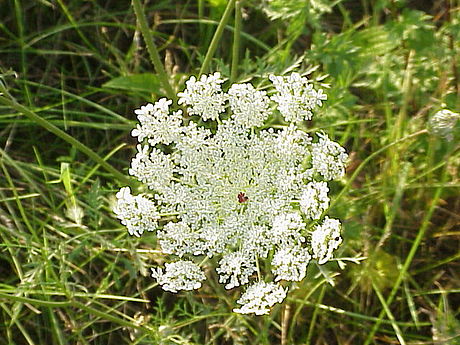Daucus is a worldwide genus of herbaceous plants of the celery family Apiaceae of which the best-known species is the cultivated carrot. Daucus has about 75 species.[1] The oldest carrot fossil is 1.3 Ma, and was found on the island of Madeira in the Atlantic Ocean.[2]
| Daucus | |
|---|---|
 | |
| Daucus carota | |
| Scientific classification | |
| Kingdom: | Plantae |
| Clade: | Tracheophytes |
| Clade: | Angiosperms |
| Clade: | Eudicots |
| Clade: | Asterids |
| Order: | Apiales |
| Family: | Apiaceae |
| Subfamily: | Apioideae |
| Tribe: | Scandiceae |
| Subtribe: | Daucinae |
| Genus: | Daucus L., 1753 |
| Species | |
|
See text | |
| Synonyms | |
|
List
| |
Description
Members of Daucus are distinguished within the family Apiaceae by their leaves which are 2–3 pinnatisect with narrow end sections. The genus primarily consists of biennial plants but also includes some annual plants and some perennial herbs. All Daucus have bristly stems. The inflorescences are umbels. The flowers are mostly white, with bracts and bracteoles. The petals may be pure white, reddish, pinkish or yellowish. They are emarginate above and have pointed, wrapped lobules. The petals are often unequal in size, with petals at the outermost edge of the inflorescence often being larger. The fruit is an ovoid to ellipsoidal schizocarp, cylindrical or compressed, with ciliate primary ribs and secondary ribs with a row of hooked spines.[3] Some species have a small pale or white edible taproot, similar to a radish, which may or may not be bitter in taste.
Ecology
Daucus pollination is carried out by insects, primarily: Lepidoptera, Coleoptera, Diptera, and Hymenoptera. It is a cosmopolitan genus with endemic species on most continents as well as on many islands and in isolated areas.[citation needed] The genus centre is in North Africa and Southwest Asia in the Temperate Zone.[citation needed] Prolonged dry or cold weather tends to retard growth in Daucus species, but the genus as a whole is evolutionarily adaptative to these conditions.[citation needed] Some Daucus species accumulate substantial resources in large underground taproots without impeding plant development.[citation needed] Native to Europe is the carrot, with several subspecies, including subsp. carota (wild carrot), subsp. gummifer (sea carrot) and subsp. sativus, a cultivated form of carrot, also called garden carrot).
Four members of the Daucus genus were examined to determine differences in isoenzyme patterns and plastid DNA. The four were: Daucus carota subspecies sativus cultivar Danvers, D. carota subsp. gummifer, D. capillifolius, and D. pusillus. Although only one form of HSDH (homoserine dehydrogenase) was present in each Daucus line, the rate of migration of HSDH from cv. Danvers was different from that of the others. Multiple isoenzymic forms of ADH were present in each Daucus cultivar. Comparison of endonuclease restriction fragment patterns from plastid DNAs digested by BamHI revealed only small differences between plastid DNAs of cv. Danvers and subsp. gummifer, whereas large differences were observed between cv. Danvers and D. pusillus plastid DNA patterns. No differences were found between cv. Danvers and D. capillifolius plastid DNA patterns when examined using eight different restriction enzymes. The data indicate that specific isoenzyme and organelle DNA restriction fragment patterns will be useful markers for precise identification of genomes of different Daucus species.[4]
Systematics
The genus comprises about 75 species,[1] including:
- Daucus aureus Desfontaines; yellow fruit's carrot, golden carrot
- Daucus aleppicus J.Thiébaut; Lebanon and Syria
- Daucus annuus (Bég.) Wojew., Reduron, Banasiak & Spalik; Cape Verde (synonymous with D. carota ssp. annuus)
- Daucus arcanus F.García Mart. & Silvestre (syn. with D. pusillus)
- Daucus aureus Desf.; Northern Africa, Mediterranean
- Daucus biseriatus Murb.; Algeria, Morocco
- Daucus broteri Tenore; Brotero's carrot; Southeastern Europe to Iran
- Daucus capillifolius (Gilli) Arbizu; Libya (syn. with D. carota ssp. capillifolius)
- Daucus carota L.; wild carrot, ‘Queen Anne’s lace’
- Daucus crinitus (Boiss.) Kuntze; Iraq to Pakistan (syn. with Psammogeton canescens subsp. canescens)
- Daucus decipiens (Schrad. & J.C.Wendl.) Spalik, Wojew., Banasiak & Reduron; Macaronesia
- Daucus della-cellae (Asch. & Barbey ex E.A.Durand & Barratte) Spalik, Banasiak & Reduron
- Daucus durieua Lange; Durieu's carrot; Canary Islands, Iberian Peninsula, Levant
- Daucus edulis Lowe, Wojew., Reduron, Banasiak & Spalik; Madeira, Selvagens
- Daucus elegans
- Daucus glaberrimus
- Daucus glochidiatus (La Billardière) Fisch., C.A.Mey. & Avé-Lall.
- Daucus gracilis
- Daucus guttatus Sibthorp & Smith
- Daucus hirtus
- Daucus hochstetteri
- Daucus humilis
- Daucus incognitus
- Daucus insularis (Parl.) Spalik, Wojew., Banasiak & Reduron; Cape Verde
- Daucus involucratus
- Daucus jordanicus
- Daucus littoralis Sibthorp & Smith
- Daucus mauritii
- Daucus melananthos
- Daucus microscias
- Daucus minusculus
- Daucus mirabilis
- Daucus montanus Humb. & Bonpl. ex Spreng.
- Daucus muricatus* (L.) L.
- Daucus pedunculatus
- Daucus pumilus (L.) Hoffmanns. & Link; Canary Islands
- Daucus pusillus Michx.; American wild carrot
- Daucus reboudii
- Daucus ribeirensis
- Daucus rouyi
- Daucus sahariensis
- Daucus setifolius
- Daucus tenuisectus
- Daucus tenuissimus
- Daucus virgatus
- Daucus yemenensis
Allergenicity
Daucus has an OPALS allergy scale rating of 10 out of 10, indicating extremely high potential to cause allergic reactions.[5]
References
External links
Wikiwand in your browser!
Seamless Wikipedia browsing. On steroids.
Every time you click a link to Wikipedia, Wiktionary or Wikiquote in your browser's search results, it will show the modern Wikiwand interface.
Wikiwand extension is a five stars, simple, with minimum permission required to keep your browsing private, safe and transparent.
